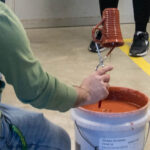There are still young girls who miss school because they do not have menstrual pads and cannot afford to buy them. Period poverty is a major problem to young girls and in our society.
Many young girls are unable to attend school because sometimes during their menstrual days, they do not have menstrual pads. Some resort to using cloths, rags, tissues or paper towels that are taken from public toilets, just to prevent their menstruation from leaking. This type of practice makes it evident that menstruation can be a barrier to accessing education freely.
One societal ailment we face is menstrual poverty, but it doesn’t get enough attention.
Period poverty simply refers to the inability to afford menstrual products such as menstrual pads, tampons or liners.
I can imagine how frustrating it is having to go through period pains and worry about where you are going to get your next pad. Some females may not relate to this type of unfortunate situation because they never had to go through the pain of not having menstrual pads.
Menstrual products are not cheap. An average price of a pack of menstrual pads may cost about $5. That is about $60 per year, which is too much for someone who cannot afford to buy one for themselves or a parent buying for their child.
To make matters worse, there is an additional charge of sales tax on top of the initial cost. Menstrual pads are taxed by the government in some states. It is sad to discover that there are now 33 states that are taxing menstrual products. Unfortunately, Iowa happens to be one of them.
I think this is quite ridiculous for the government to tax menstrual products because menstruation is not a choice, but human nature. We must not forget that period products are not luxury items, but a basic human necessity for females.
Have you ever heard of reusable menstrual pads? Reusable menstrual pads are menstrual pads that are made of soft cotton cloth, and they serve as an alternative to disposable menstrual pads. They work the same way as the disposable ones, the only difference is that they are reusable. One of the good things about this type of menstrual pads is that you can reuse them for over five years. After use, you just wash it with lukewarm or hot water with some soap and dry it for the next use.
Reusable menstrual pads are worthwhile for females, especially for those who struggle to get their menstrual pads monthly. If you were to buy reusable menstrual products, it would be better because you will be buying a product that will last five years and save a lot of money.
The reusable menstrual pad will likely reduce the issue of young girls not attending school during their periods, and the reusable pads will, among other advantages, boost school attendance for females, reduce anxiety about periods, cause less worry about stains and relieve the stress of how to get their next pad.
Kirkwood Community College has a food pantry for students, and one of the items it gives out is menstrual pads. I applaud the food pantry for the splendid work it does by ensuring that girls get menstrual pads, but we must not forget that the food pantry depends on external and internal donations. There is no sustainability in giving out these monthly menstrual pads.
I think that if the food pantry can introduce and promote the use of reusable menstrual pads, it could save a lot of stress for female students. I believe that it is a socio-economic bargain because female students can now worry about other things than having a menstrual pad.
Even though reusable menstrual pads might not be the golden solution, at least they are playing a role in instilling and enhancing the integrity of girls in our societies.

Categories: Editorials, Opinion










